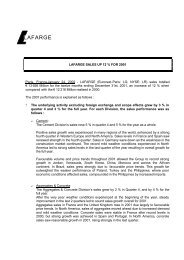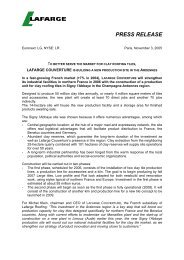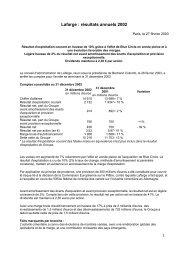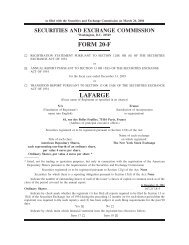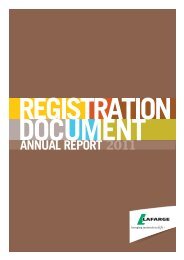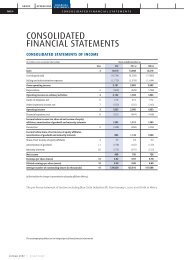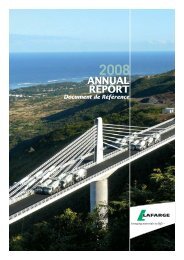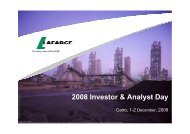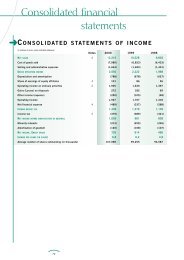2005 Sustainability Report - Lafarge
2005 Sustainability Report - Lafarge
2005 Sustainability Report - Lafarge
Create successful ePaper yourself
Turn your PDF publications into a flip-book with our unique Google optimized e-Paper software.
PANEL<br />
Contributing to local economic development<br />
Managing our multi-local<br />
development<br />
MANAGING POLITICAL,<br />
ECONOMIC AND<br />
FINANCIAL ISSUES LINKED<br />
TO OUR LOCATIONS<br />
Guiding our investment<br />
decisions<br />
Investments above €25 million are<br />
under the responsibility of the<br />
Group Executive Committee. A global<br />
investment budget is approved for each<br />
country and takes into account political,<br />
economic and financial risks. Each year,<br />
we circulate the updated country risk<br />
analysis methodology to all the Group's<br />
units. In 2004, we updated the<br />
weighting of the “country risk” rating<br />
and took into account Transparency<br />
International's recommendation to<br />
increase the weighting of corruptionrelated<br />
criteria (political risk), which<br />
was thus increased from 8% to 15%. This<br />
country risk rating prompted us to<br />
draw up a list of ten or so countries,<br />
exceeding the threshold tolerated by<br />
MARION HELLMANN<br />
BWI<br />
PAGE 36 | <strong>2005</strong> SUSTAINABILITY REPORT | LAFARGE<br />
<strong>Lafarge</strong> based on the criterion of<br />
political risk, which does not cover<br />
China.<br />
Ensuring that Human Rights<br />
are respected in the countries<br />
where we are present:<br />
the example of China<br />
<strong>Lafarge</strong> is developing in China in the<br />
total respect of its Principles of action.<br />
In order to enable its new units to<br />
benefit from its experience, <strong>Lafarge</strong><br />
is implementing a management system<br />
that favors respect and individual<br />
development, occupational safety and<br />
training. For 11 years, <strong>Lafarge</strong> has been<br />
developing progressively in China. Until<br />
2004, <strong>Lafarge</strong> operated 13 sites. After<br />
a joint venture with the Hong Kong<br />
group Shui On, the Group acquired 7<br />
new sites which considerably increased<br />
the scope. With this sharp increase in<br />
the scope new issues have arisen which<br />
have to be considered by <strong>Lafarge</strong>.<br />
The Group needs to provide human<br />
resources that are capable of ensuring<br />
the integration. The integration plan<br />
will start in 2006 with audits in different<br />
areas: social integration, safety,<br />
technical evaluation… and with the<br />
setting up of local teams, supported by<br />
international teams.<br />
The driving effect across the entire<br />
industrial sector is becoming stronger<br />
over time. The priority placed on<br />
training and developing employees,<br />
with the opportunity to pursue an<br />
international career, makes them<br />
receptive to new organizational and<br />
working methods.<br />
<strong>Lafarge</strong> has been present in China for over 11 years and should therefore be more transparent on<br />
the impact of their operations on workers and local communities with regard to employment, social<br />
and environmental conditions. The report does not explain why China is not included in the Group’s<br />
list of high political risk countries and why <strong>Lafarge</strong> has increased its business in countries with<br />
a critical Human Rights record between 2003 and 2004. Finally, I would like to see third party<br />
verification of <strong>Lafarge</strong>’s performance in matters of Human Rights in the workplace, both through<br />
external audits and involvement of concerned stakeholders.




